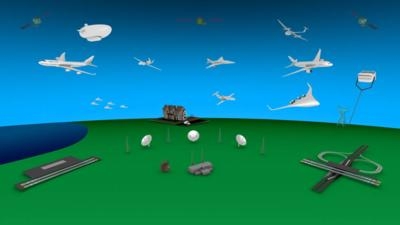Proposals Must Be Submitted To The Agency By The End Of This Month
NASA is looking to the public to continue that tradition by contributing new ideas for the future of air travel.

Sky for All: Air Mobility for 2035 and Beyond is a $15,000 challenge to develop ideas for technologies that could be part of a clean-slate, revolutionary design and concept of operations for the airspace of the future. The challenge, which is administered by HeroX, opened Dec. 21. The deadline for submissions is Feb. 26, 2016.
The design challenge, sponsored by NASA’s Aeronautics Research Mission Directorate (ARMD), asks potential solvers to think outside the current air traffic management system box, and consider how to manage crowded skies, autonomous operations and cyber security of the system.
“Twenty years from now, people may be surprised about the number and kind of vehicles sharing the skies,” said Parimal Kopardekar, ARMD’s Safe Autonomous Operations Systems (SASO) project manager. “We anticipate there will be personal air vehicles, passenger jets, and unmanned aircraft of various sizes and speeds flying at a variety of altitudes, as well as commercial space launches, spacecraft and even stationary objects like wind turbines.”
What the team wants from the public is new ideas – perhaps something researchers haven't thought of yet that could help revolutionize how traffic is managed in the airspace. Among the factors NASA wants participants to consider is how to design a robust system that can scale up to full capacity under normal operations and scale back to equally safe reduced capacity under poor conditions, like bad weather. Ideas may also consider autonomous adaptation of the system, and protection from possible cyber security attacks.
“Because of the complexity of designing a system that is expected to handle 10 million crewed and uncrewed aircraft in the skies, we are looking for innovative ideas from the public that enhance the work NASA researchers are doing right now,” said Natalia Alexandrov, lead of the Ab Initio Design for Autonomous Airspace Operations, a foundational research element in ARMD’s SASO Project.
NASA is asking innovators to disregard current transportation infrastructure and constraints. Submissions should include a full description of the design, including safety features and an explanation of how the new air transportation system would interact with others forms of transportation, including ground and sea.
“I am so proud that HeroX and NASA are partnering on this exciting challenge,” said Peter Diamandis, chairman and chief executive officer of XPRIZE and co-founder of HeroX. “Incentive prizes have played an incredible historical role in shaping the aerospace industry ranging from the Orteig Prize to the Ansari XPRIZE. I can’t wait to see the breakthrough ideas that will result from the NASA Sky for All Challenge.”
The Sky for All challenge is managed by NASA’s Center of Excellence for Collaborative Innovation (CoECI). CoECI was established with support from the White House Office of Science and Technology Policy to assist NASA and other federal agencies in using new tools – such as challenges – to solve tough, mission-critical problems. The Center launches challenges under the umbrella of the NASA Tournament Lab and offers a variety of open innovation platforms that engage the crowdsourcing community in challenges to create the most innovative, efficient and optimal solutions for specific, real world challenges.
(Graphic provided by NASA)
 ANN's Daily Aero-Term (05.09.24): Hold Procedure
ANN's Daily Aero-Term (05.09.24): Hold Procedure ANN's Daily Aero-Term (05.06.24): Altitude Readout
ANN's Daily Aero-Term (05.06.24): Altitude Readout ANN's Daily Aero-Linx (05.06.24)
ANN's Daily Aero-Linx (05.06.24) Airborne-NextGen 05.07.24: AI-Piloted F-16, AgEagle, 1st 2 WorldView Sats
Airborne-NextGen 05.07.24: AI-Piloted F-16, AgEagle, 1st 2 WorldView Sats Aero-News: Quote of the Day (05.07.24)
Aero-News: Quote of the Day (05.07.24)



